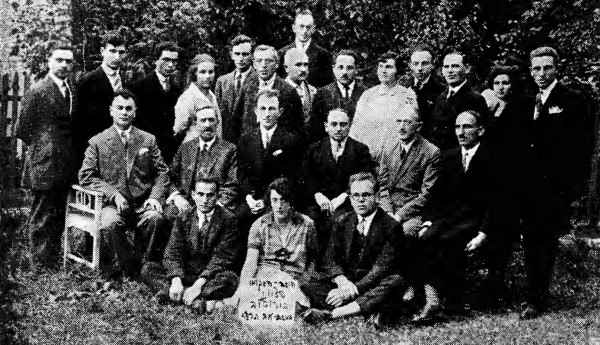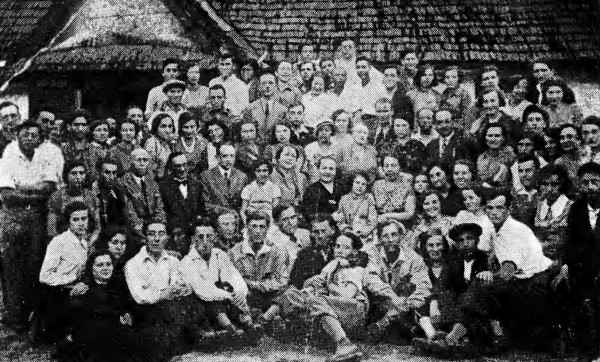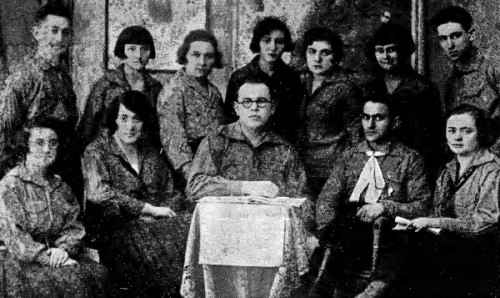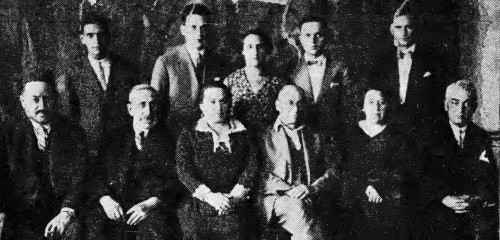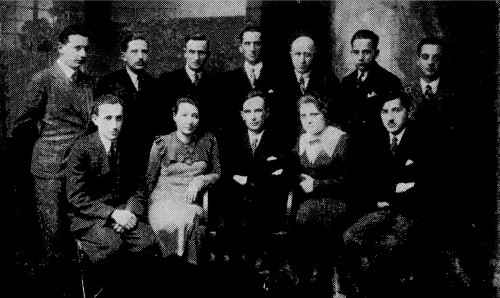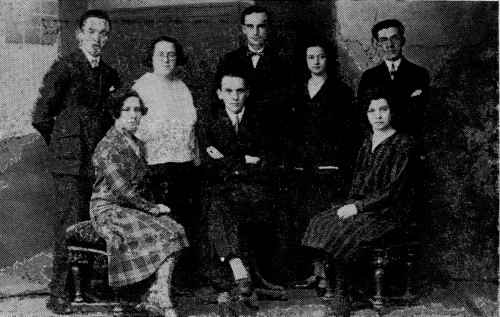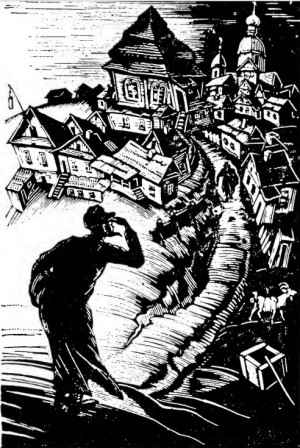[Page 93]
Zionist Parties
and Youth Movements
The beginnings of the Zionist Movements in Jaroslaw
by Moshe Kalchheim
Translated by Selwyn Rose
The data we have suggests that the Zionist movement in Jaroslaw started to organize at the beginning of the 80's of the 19th century, at the time of the “Ḥovevei Zion” movement in Russia and Austria, that is to say, before the appearance of Dr. Theodore Herzl on the Zionist “stage”.
In 1889, on the initiative of Dr. Reuven Bierer, the “Jewish National Academic Society” – “Kadima” was founded and among the 54 members of the Society were the student Emil Blumenfeld and Dr. Salo Rosberger of Jaroslaw. “Kadima”, was therefore the first Zionist organization created in Jaroslaw.
In 1892 Dr. Nathan Birnbaum – one of the leading figures of “Ḥovevei Zion” of the period - visited Jaroslaw, with the intention of reorganizing all the Zionist organizations under the name “Settlement of the Land of Israel”, the target of which would be the collection of money and donations for advancing the establishment of settlements in Palestine.
In 1894, Jaroslaw already had an active branch named “Settlement of the Land of Israel” called “Zion”, and at a national conference in Lvóv that took place on 30th and 31st of August that year, Shimon Brenner, the representative of Jaroslaw, reported on Zionist activities in our town.
The conference also instituted a new body called “The Political Society of Galician Jews”, directed towards “Zionist education of the Jewish populace, work for all Jewish needs, especially political and economic, safeguarding the rights of Jews as citizens of the country and State and as members of the towns and communities.”
Dr. Emil Blumenfeld of Jaroslaw was elected as president of the Society. The fourth conference of the Galician Jews that convened on 25th October 1896 in Lvóv, elected Dr. Salo Rosberger as a member of the central committee of Galician Zionism.
Another central personality in Zionist life in Galicia was Rabbi Leibish
[Page 94]
|
|
The local Jaroslaw Zionist Committee in 1927
Standing R to L: Hirsch Hariton, Rivka Ludmir, Diamont, L. Matzner, Mrs. Potascher,
Raphael Gatzhow, Weissler, A Tanzer, Shalom Stolbach, Attorney A Reszler, Moshe Beitler
Sitting from R to L: Dr. Yitzhak Rabinowitz, Dr. Moshe (Mauritz) Shafetz (Chairman). Izzio Leon,
Elimeleḥ Reich, Dr. Freizman
Sitting below: Manar, Izzio Horowitch, Devora Wolfsztejn, Jacek Zelinkowski |
Mendel Landau who during the Nineties of the 19th Century was the town's Rabbi. He was born in 1861 in a small village near Jaroslaw and from the beginnings of Zionist activities, he joined the movement and was active in disseminating the Zionist ideology in Galicia. The Rabbi of Belz[1] was openly hostile to the movement because of its Zionist activities and several times tended strongly to frustrate and indeed sabotage the Rabbi's attempts at being elected as the community Rabbi (as was the case in Kolomyia) and also his attempts to become Rabbi of Jaroslaw were obstructed by the fierce resistance of the Belz Rabbi who, by informing the authorities of their activities, hoped to have his candidacy invalidated.
In the book by Dr. N. M. Gelber, “A History of the Zionist Movement in Galicia”, we find the following passage:
“In 1891 a “reading room” reflecting a national character was established here (in Jaroslaw – MK). Although two members of the Viennese “Kadima” – The lawyer Dr. Emil Blumenfeld and Dr. Salo Rosberger as well as the publisher of “The Treasure of Literature”
[Page 95]
Shaltiel Isaac Graber who was one of the veteran members of the National Movement lived in Jaroslaw; they were not inclined to found a Zionist Society… “The first Zionist Society was founded in 1894. Representatives of the National Committee in Lvóv came in January; The Chief Rabbi, Leibush-Mendel Landau, David Schreiber and Shimon Rantzer and their assistants Dr. Blumenfeld and Dr. Rosberger convened a meeting on the 8th January inviting the intellectual circles of the community. After an opening address by Dr. Blumenthal, Schreiber spoke about the conditions of the Jewish people in the countries of the Diaspora and pointed out the damage that assimilation was bringing upon the Jews as a united front based on historic traditions…”
In the debate, Dr. Landau[2] attempted to prove that through emancipation, the Jewish question would be solved and the Jews should become assimilated with the Polish people. To that Dr. Rabbi Landau, Dr. Rosberger, Rantzer and David Schreiber gave the answer. Their words made a deep impression on the gathering that decided to create a committee to establish the “Zion” society. Dr. Blumenthal, the Community head, Heinrich Strisower, Natan Kutzman, Clement Maschler, Shaltiel Isaac Grauer, Attorney Shmuel Nebenzahl, B. Pomeranz, Ḥaim Kaufmann, Dr. Rosberger and Leon Hayil were elected.
On 25th November 1894 a local branch of the “Settlement of the Land of Israel” – “Zion” was established. 150 new members joined the Society following the meeting, addressed by Rabbi Leibush-Mendel Landau, Dr. Gershon Zipper and Dr. Rosberger, where they called for support of the settlement project. Dr. Blumenthal was elected President and Dr. Salo Rosberger -Vice-President, Yitzhak Wausza (apparently Gausza – M.K.) - Treasurer, Shlomo Stitzel - secretary for development of the land, Shaltiel Isaac Grauer – Hebrew secretary and Yisrael Schusseim, Ya'acov Goldschmidt, David Kornman David Weinberg, Shmuel Brenner, Shaul Sternal, Shlomo Mandelberg, Yosef Kaufteil and Marcus Krieger.
[Page 96]
The first convention of the Movement took place in Lvóv and the second, as it happens, in Jaroslaw - (In 1902); it speaks significantly for the importance of that town that it was so.
The name of the Movement in Jaroslaw was “Shaḥar” – “The Dawn” and represented an integral part of the National Society as “The Zionist Academic Federation” with the aim of: “elevating the spiritual status of the Zionist youth by National-Zionist education and creating a permanent connection between the corporations and the individual Societies.”
A special honor fell upon part of the Jaroslaw Zionists with the election by the National Council of Dr. Emil Blumenthal, the President of “Zion” as a delegate to the First Zionist Congress.
He was one among 23 delegates from Galicia who took part in the Congress and his photograph appears in the published photograph of the delegates of the First Zionist Congress.
In 1903, there were three Zionist societies in Jaroslaw:
“Sons of Zion” headed by Dr Eberzohn;
“Raḥel” headed by Mrs. Regina Dykess;
“Aḥvah” headed by Heinrich Zumpf.
That same year in Jaroslaw, a counseling session took place among the members of the National Council concerning national work of the Zionist movement.
Regarding the youth movements, it is worth noting that they were composed of students and graduates of the various gymnasia throughout all the towns of Galicia. We do not have much detail about the size of the movement except that in 1913, at the time the Federation Council was convening in Przemyśl “Shahar” had 28 members five of whom spoke Hebrew, and was represented at the meeting by two of its members: Benno Ḥamiadas and Wilhelm Genisfal.
“Shahar” also had a youth movement – “Young Zion” close to and deeply interested in the question of Socialism and tended to follow the “Poalei Zion” then organizing in Galicia.
In 1911, “Young Zion” numbered 18 members in Jaroslaw of whom ten members were learning Hebrew.
* * *
Another aspect of Zionist life in Jaroslaw concerned the Hebrew teachers,
[Page 97]
|
|
The local Zionist Committee with a group of “Ḥalutzim Akiva”
pioneers during their training in Jaroslaw |
who were organized in the Hebrew movement in Galicia. The Movement had its beginnings in 1893 with the foundation of the first Hebrew school in the town of Jaroslaw.
In 1906, the “Society of Hebrew Teachers in Austria” came into being with the aim “…to educate the young generation with a National-Hebrew spirit and to revive the Hebrew language.” At the same time, there existed 21 schools and courses in Hebrew in Galicia and Bukovina, among them Jaroslaw, named: “Clear Speech” (“Safa Brura”) with 66 students under the management of Mrs. Zippora Haber.
*
As we have said, there was a Socialist youth movement in Jaroslaw “Young Zion” but before them there existed a branch of a labor movement named “Ivri” that contained within it laborers and assistants to traders and businessmen. The “Ivri” Society represented an integral part of “The federation of Zionist Worker and Laborers in Galicia” and it numbered in 1903 one hundred and eighty members. From among its roots sprang one of the prominent leaders of
[Page 98]
|
|
A group of Zionist workers
Sitting from L to R: ?, ?, I. Zelinkowski, Horowitz, Dora Wolfstein
Standing from L to R: ?, ?, Zelinkowski, Beitler, B. Schlissberg, S. Striks, S. Lieberman, ?, ? |
“Poalei Zion” in Galicia, the engineer Anslem (Anschel) Reiss who already in 1910 was elected as representative at the ninth congress to the board of Management of the “Poalei Zion” in Austria and has continued as an active participant to the present day.
Also elected to the same council was the second delegate of the movement in Jaroslaw, the well-known doctor, Adolph Hendl.
* * *
From the details mentioned above about the beginnings of the Zionist Movement in Jaroslaw, we learn that the Jewish community in our town was significantly involved and active in the development of Zionist activity in Galicia and the town's public activists fulfilled a central role in the life of the Movement from its very beginnings until the last days of the existence of the Jewish community in the town.
Translator's Footnotes
- Although not specifically named in the text, the available chronology and other sources suggest that he was Rebbe Yehoshua Rokeach (1855-1891) of the Belz Yeshiva dynasty Return
- Dr. Landau was a noted Assimilationist in Jaroslaw. Return
[Page 99]
Zionist Activities in Jaroslaw
During the 1920's
by Asher Graf
Translated by Selwyn Rose
After the ratification of the British Mandate over the Land of Israel in San Remo, recognition of the importance of the idea of “Love of Zion” increased and the longing for the return to Zion took a more tangible form.
The “awakening” found expression in establishing and organizing Zionist institutions and organizations in their several forms, including cultural foundations whose nature and importance will be addressed in this article.
The activity included a large part of the Jewish public in Jaroslaw that expressed a readiness to act upon all the instructions of the Zionist Federation in West Galicia, based in Kraków. A large number of activists responded eagerly, contributing to the various National funds like: The Foundation Fund, the Jewish National Fund and many other active causes that the times demanded. During this period, various youth movements, each according to its particular program and political stream, also came into being. The pioneering youth movements also established themselves and in 1919, the first group of pioneers, numbering about twenty members, immigrated to Palestine.
Among the participants in that group were: the brothers Shalom and Shmuel Spiegel and Kurzman. Shalom Spiegel is now a Professor at Yeshiva University in New York and Shmuel Spiegel (Sam Spiegel) is the well-know film producer in America while Lusk (Ludwig) Kurzman is today known as Arieh Sharon, the well-known architect.
Simultaneous with the wide-spreading Zionist awakening, cultural activities, both Hebrew and national also struck deep roots. A branch of the “Tarbut” society arose and it is to their credit at that time, that a string of impressive cultural activities can be recorded. A library came into being that included books in Hebrew and other languages, and in time grew to become a cultural asset for the youth and adults.
The librarian, during these years was Sela Striks and it is due to her work and dedication that the library became what, in fact, it was – an institution of great value.
The cultural activities of that time included the involvement of many hundreds of the Jaroslaw youth requiring the local Zionist council that was comprised of delegates of almost all the Zionist organizations – to rent Beit Sobell, which contained about ten rooms and a meeting-hall of about one-hundred square meters. The Beit Sobell foundation concentrated within its activities hundreds of students studying Hebrew.
The management of the house, that gave it the name “Beit Ha'am” - “The People's House”, opened courses for studying Hebrew, employed two full-time teachers: Devora Wachner and Rivka Ludmir
[Page 100]
|
|
The local Zionist Committee
Sitting from R to L: Dr. Rager, X, X, Dr. Rosberger, Mrs. Morenberg, E Rich, S Spiegel
Standing R to L: S Graff, B. Licht, Mrs. S. Charitan, L. Melon, G. Zielinkowski |
and the veteran teacher Halimer on a part-time basis. The majority of the youth at that time, acquired the Hebrew language there.
My late brother Joshua Graf conducted much work teaching the Hebrew language, with great dedication for years and with no thought of “winning a medal” until he immigrated to Israel in 1926.
During that same period a Hebrew-Polish school was founded and recognized by
[Page 101]
the Government. In the beginning, the school was situated in the Chopin School of Music building but after some time the school transferred to the building belonging to the Horn family.
The school came into being thanks to the dedicated work and inspiration of Dr. Yitzhak Rabinowitz (Z”L) and the time he invested in its creation it succeeded and developed. A children's nursery was also created and employed two pre-school teachers.
The extensive and well-attended activities continued until near the end of the thirties. Following the economic crisis in Palestine, the disturbances caused by the Arabs in the country and the difficulties the Mandatory authorities created regarding immigration, the attendance and associated numbers began to gradually decline and the courses suffered from the lack of attendance. The numbers of youths that had frequented “Beit Ha'am” on Sabbath eves and enjoyed enthusiastically dancing the Hora, diminished more and more.
|
|
The “B'nei Zion” Management
Standing from R to L: Brat, Metzger, Ziga, Dobschitz, Schneebaum, Gertner, Wasserman, Olek Silberman
Sitting from R to L: Wintergrin, N. Rot, Simcha Graf, Sianka Nas, Siku Schleider |
[Page 102]
The Management of “The People's House” was forced to evacuate the building because of financial and other difficulties. It goes without saying that the various Zionist and other organizations also reduced the extent of their activities.
At the same time, towards the end of the 1930s, two adolescent Zionist activists recognized that it was necessary to adapt the shape of national activity to the present situation as is and to establish a Zionist association that would centralize university students and also those culturally and socially able to find their place in it, giving them the opportunity to play their part in national action, thus was founded and created “B'nei Zion” association.
|
|
The “Tarbut” Management, 1926
Standing from R to L: S. Stulbach, R. Ludmer, S. Graff, D, Wachner, L. Metzger
Sitting from R to L: Schtulbach, I Rosenblit |
[Page 103]
“WIZO”
Mrs. H. Halberstam
The womenfolk of the Zionist Movement in our town fulfilled an honored role.
From 1923, Mrs. Franya Pacher (Z”L), Mrs. Pohorilles (Z”L), Mrs. Lute Turnheim (today in Israel), and other women, known as Zionists organized themselves into a “Jewish Women's Circle”. Mrs. Blumenfeld of Slowatzki Street headed the organization. The circle had official standing under the auspices of Ms. Meltzer from Lvóv; Mrs. Meltzer was a senator in the Polish parliament. She was invited to our town, to a general meeting and banquet in which nearly all the leaders of the Zionist Movement took part, among whom were Dr. Rabinowitz, Dr. Spatz, Dr. Schwarzer, Dr. Rager and others.
The organization directed its activities to cultural and Zionist topics. Meetings were held in members' homes and normally one of them would prepare a topic for conversation or debate: on education, culture or Zionism.
After the founding in London of the Federation of Women Zionists (“WIZO”) in 1924, a delegation of the organization arrived in Jaroslaw. Mrs. Ada Maimon of Palestine also visited us as did Sabba Gottlieb of Kraków, now living in America.
Then there was a big meeting in the “Yad Ḥarutzim” meeting-hall and it was decided to join “WIZO”. Our center was in Kraków. We began with mobilizing the women in “WIZO” whose membership numbered four hundred. Among the activists in the organization were thirty women members.
Mrs. Hurt, Mrs. Kurzman and Mrs. Storch were elected as a management.
The treasury was handled by Mrs. Rager and Mrs. Rabinowitz (today in Israel), Mrs. Ludmir (today residing in Israel), Mrs. Schlafrig and Mrs. Weinbaum who was for a period the secretary of the Management (today in Israel), Mrs. Franya Morenberg and Mrs. Ada Emmar.
“WIZO's” work program was far-reaching. The “WIZO” organization took part in every Zionist activity in town helping pioneers, the Foundation Fund of Israel, the Jewish National Fund and other activities.
The women of “WIZO” met on Wednesdays to debate issues of the day and the town. Our club functioned in collaboration with the local council. These meetings segued into social gatherings to listen, to learn, to see and to be seen.
[Page 104]
The women organized festivals. Like Purim and Hanukah, or displays of handicrafts and the proceeds transferred to “WIZO” in Palestine. We were visited by members from the Center in Kraków – Mrs. Maria Afte, the writer and Gusta Lindenbaum-Cohen, who complimented us on our work encouraging us with their words.
Our activities for the young members of “WIZO” won an honored part of our work – there were those young ladies, still students in school or who had learned a profession and were thinking of immigrating to Palestine.
Each Saturday afternoon, I met with them at the club (the home of Mrs. Schlafrig.). There, I gave lectures on the history of the Judaism, Zionism and the geography of the Land of Israel. With the help of Dr. Rabinowitz, we managed to collect sufficient sums that enabled some of them to make Aliyah.
“WIZO” earned a name for itself even among non-Zionists, as an active organization. In 1929, the winter was particularly severe in Poland and Mr. Strisower, who was the Deputy Mayor at the time asked for our help in opening an emergency kitchen for the needy. We managed the kitchen ourselves with financial help from the Municipality.
That same year, we were visited by Mrs. Pozner of the Jewish National Fund who came from Palestine. We managed to raise 100 Dollars in order to register the name of Poland in the Golden Book of the National Fund, celebrating the tenth year of its independence.
In 1930, with the help of Dr. Rabinowitz, a Hebrew school was founded in which the language of instruction was, nevertheless, Polish but the curriculum included Hebrew and other Jewish topics. We assisted in getting Jewish girls to attend the school and provided whatever else they needed.
In that school, we saw the beginning of the Hebrew education that we wanted to instill in our children and who knows what fruits would have been born of it, had it not been for this terrible last war.
The Second World War put an end to the work of “WIZO” as well, together with the deaths of hundreds of its members who perished in the Holocaust that came upon us at the hands of the murderous Germans.
[Page 105]
The “Mizraḥi” Movement in Jaroslaw
(From its founding until the Thirties)
by Moishe`leh Kalchheim, Jerusalem
Translated by Selwyn Rose
The “Mizraḥi” movement in our town included the elderly, the young, pioneers and “Ha-Shomer Ha-Dati” (The “Religious Guard”). All of them were imbued with the great idealistic spirit: the building of the Land of Israel inspired by Religious Zionism. Even before “Hertzlian” Zionism, famous and well-known Rabbis - “Greats” of the Torah, and of “Ḥovevei Zion” – (“Lovers of Zion”) belonged to the Movement.
Up until the First World War, there were only single men who belonged to Mizraḥi in Jaroslaw. The Federation did not yet exist and these individuals had much influence.
One must recall the historical fact concerning the Mizraḥi Movement. From 1867 Rabbi Shmuel Walberg was the Chief Rabbi of the town (he officiated for about ten years, before which he had been the Rabbi of Żółkiew (Zhovkva)). He was the author of five books: “Imrei Da'at”, (“Words of Knowledge”), “Ateret Shoshanim” (“A Crown of Roses”), “Devar B'ito”(“Timely Words”), “Darkei Shinu`im” (“The Ways of Change”) and “Divrei Shmuel” (“Sayings of Shmuel”), an A to Z book of glosses and explanations; he died in 1906 at the age of seventy-seven.
The community leaders sought a town Rabbi in about 1910; several Rabbis appeared offering their services to the community together with their demands. The candidates were: Rabbi Leibush Mendel Landau, Rabbi Meir Horowitz of Kozats'ke, Rabbi Ziff of Lvóv, the Rabbi of Turka and others. The election committee numbered 16 community members and a further 16, holders voting rights through “Power of Attorney” of the electorate. (My father (Z”L), was among the electors).
By all accounts, Rabbi Leibush Mendel Landau should have had the greatest chance of being chosen but the Ḥassidim of Belz and Sieniawa (Shinova), objected fiercely to his election. The main cause of their objections stemmed from his dedication to Zionism and as one of the leaders of the “Ḥovevei Zion” movement in Galicia and a co-founder of the world Mizraḥi movement. Rabbi Landau had also been a candidate for the Rabbi's seat in Kolomyia and there, too, the Belz Ḥassidim had thwarted his attempts at election. In the elections for community Rabbi in Jaroslaw, Rabbi Landau received more than twenty votes out of the 32 possible but one Belz Ḥassid craftily deposited two voting slips in place of one. At the count, there appeared 33 votes instead of 32. It seems likely that it was done with either the agreement or the actual participation of the town Marshal and as a result, the elections were declared invalid.
[Page 106]
It was during this period that the influence of Mizraḥi found expression. Rabbi Gedaliah Schmelkes – the Rabbi of the town Przemyśl, engineered a propaganda war in favor of the friend of his student days and ideological opinions. Rabbi Natan Levine – the Rabbi of Rzeszów (Raysha), also supported him when the three of them were students of the Gaon, Rabbi Yitzhak Schmelkes of Lvóv. (The Rabbi Natan Levine was the son-in-law of Rabbi Schmelkes (Z”L)).
In 1920, Rabbi Landau was elected almost unanimously as the Rabbi of the town but nevertheless after a short while in office he passed away.
The awakening in the consolidation of the ranks the Mizraḥi in town began after the First World War. Significant influence and a deep impression was made upon us by the appearance of the delegate from the Warsaw central office, Rabbi Y. Rappoport of Jędrzejów (Yendzshev) who spoke with the utmost grace and laid the foundation for the framework of the Movement in Jaroslaw.
In 1920, the Religious Zionists began their activities in town. Among the veterans of the Movement were: Chairman Shimon Spiegel, Elimeleḥ Reich, Ḥaim-Aharon Zilbiger, Noah Lemm – son of the ADMOR[1] Elimeleḥ Lemm, Ben-Zion Dominitz, David Kramer, Shmuel Schleider, Asher Wegschel and others.
The youth circle elected a committee. The writer of these few lines was the Chairman and the first secretary was Ḥaim Licht who filled that position until his immigration to Palestine in 1924 together with Esther Wernberg, who married there. Another member of the committee was Mordecai Landman, the son-in-law of Julius Graff. During the first period, the young activists were Yehoshua-Herschel Graff, Simḥa Graff and Shalom Stelbach. They later left our Movement and joined the General Zionists.
During this first period, the activists were Eliezer Schiff and his brother Shalom. Eliezer immigrated to Palestine in 1922 and became the secretary of the General Federation and later worked as an insurance agent.
The meeting-place of the Mizraḥi was the Study-House and the Mizraḥi youth met there for lessons on the Torah. The lecturers were: on the Talmud – Moshe Lieber and Yeshayahu Lang. “Ḥovot Halevavot”[2] (Duties of the Heart), homiletics and legends based on the Talmud – Shimon Spiegel. The activists of the Mizraḥi Youth were: Haim Lemm, the brothers David and Yosef Halberstam (they perished in the Holocaust), Yosef and Yisrael Narzisenfeld, Hirsch Charit, Ben-Zion Licht (he died in Nahalal). Known to have acted at times as secretary were: Ze'ev Friedman and Shmuel Schleider (both of them in Israel).
Representing the local Zionist committee in the movement were the columnist, Shimon Spiegel and others. The Chairman of the “Mizraḥi Youth” following him was
[Page 107]
the writer Zisha Bak. Among the most active young members were: David Wisla, Moshe Bitler and Asher Kalchheim.
Among the conspicuous intellectuals was Rabbi Ben-Zion Dominitz who later moved to live in Łódź. Among the delegates to the national committees of Mizraḥi in Lvóv and Kraków was the writer of these lines. Yesheyahu Lang was the delegate to the convention in Warsaw in 1923.
The Leaders of Ḥaredi Judaism were in opposition the Religious Zionists and especially the Belz Ḥassidim and others. The Ḥassidim of Czortków (Chortkov) were supportive of Zionism. Clearly, no one had predicted the terrible Holocaust that was to occur but those opposing Zionism were looking from within confined horizons with no view of the future. The assimilated in one camp and the Ḥassidim in the second camp found they were in a combined struggle against Zionism. It is necessary to emphasize “Zionism” and not “Religious Zionism” was exiled by the Ḥassidim of the Rabbi Shimon (Z”L) Kloiz and it was by chance that they caught Zisha Bak with the “Book of the Covenant” and banned him from the Kloiz. Zisha Bak was a participant in the “Bat-Kol” (“Divine Voice”)[3] paper that was published by “The Mizraḥi” edited by Dr. Zeliger and was also associated with the weekly “Ha-Mitzapeh”, edited by S.M. Lazar.
The Kloiz of Rabbi Shimon was burned in 1914 during the First World War. The congregation moved to join the Kloiz of Rabbi Kehat (“May he be remembered for his Righteousness”). My father (Z”L), purchased a seat in the Kloiz along the eastern wall and when Rabbi David Marilis, the son of Rabbi Shimon, came to live in town, I permitted him to occupy my father's place. During the time I was active in the Mizraḥi, when I came to the Kloiz to pray on Shabbat, Rabbi David suddenly stopped the service and declared a short break stating: “For as long as that Mizraḥi is within the walls of this Kloiz,” because he represents a danger and preaches to our youth to turn to Zionism – may the Merciful One preserve us. The service stopped and I continued to pray alone in my place. The women in the women's section said to my mother: “Your son is very dangerous, he is taking our youngsters under the wings of the Mizraḥi,” to which my mother replied: “I'm very proud of him – you should wish you all had sons like him.” I could see that tempers were rising and when the service ended, I said to Rabbi David: “Look at the pleasure I gave you.” (He was sitting in my father's seat.) This made him very angry. He jumped from his seat and decided to call me to order in the Rabbinical Court (Beit Din).
The following day I appeared before the Beit-Din in town. I brought proof of ownership and that all I had done was legal and honest. After debating the matter, a compromise was agreed upon: I will permit Rabbi David to continue to sit in my father's place on the condition that he no longer stops the prayers.
[Page 108]
The “human material” that joined the Mizraḥi Movement was comprised mostly of Beit Midrash students. They were tied by the very fibers of their being to Jewish tradition, to the culture of Israel and imbued with the ambition for redemption and the will to leave the Diaspora and settle in the Land of Israel. These members of the movement, who immigrated to Israel, were dedicated to their activities in the Mizrahi movement, or in the Mizraḥi executive committee.
The Mizraḥi Movement educated a generation towards immigration to the Land of Israel and those who achieved that ambition laid the foundation of Mizraḥi and the Mizraḥi Worker in the Land of Israel. Our friends and members from Jaroslaw helped, strengthened and were themselves foundation to Religious Zionism, its projects and educational institutions and of all its pioneering projects in the creation of the State of Israel.
Translator's Footnotes
- ADMOR: An acrostic for the Hebrew honorific referring to a highly esteemed Rabbi usually a dynastic patriarch “ADoneinu, MOreinu, Rabbeinu,” a phrase meaning “Our Master, Our Teacher, and Our Rabbi”. Return
- A philosophical treatise dating from the 11th century by Bahya ben Joseph ibn Pakuda. For a full explanation see: https://en.wikipedia.org/wiki/Chovot_HaLevavot Return
- See: https://en.wikipedia.org/wiki/Voice_of_God Return
[Page 109]
The “Mizrachi” Organization in Jaroslaw
Between the Two World Wars
by Shmuel Schleider
Translated by Pamela Russ
[ ] translator's remarks
The “Mizrachi” organization in our town, from the beginning of the 30s until the outbreak of the Second World War, was one of the very active and influential organizations in Jaroslaw. During that period, the organization claimed about 150 friends [members] and many sympathizers, all from the older generation. Aside from that, there was a youth organization in the “Mizrachi,” called “Tzeirei Mizrachi” [“Youths of Mizrachi”]. The influence of the “Mizrachi” organization was so great in the city that there were four “Mizrachi” representatives in the community administration.
The “Mizrachi” in Jaroslaw was very active in the organizational area, and also in local politics. But the main emphasis was placed on the area of education.
The committee of that time included the following:
Shimon Shpiegel, Elimelech Reich, Chaim Aaron Zilbiger, Yosef Rosenblit, Mordechai Landman, Yeshiye Lang, Dovid Kremer, Shloime Schleider, Osher Wagshal, and Sholom Hirshfeld, all who put in a lot of strength and energy for the education of that generation. The committee also did a lot for the older generation: There were classes in Gemara [Talmud], Midrash [commentary], Ein Yakov [16th century text; commentary plus Talmud]. These lectures were given by Torah scholars.
The greatest emphasis was placed on the school “Yavneh,” which was the pride of “Mizrachi.” The director of “Yavneh” was chaver [friend/comrade] Dovid Kremer, who struggled, with great sacrifice, for the existence of the school “Yavneh.”
“Yavneh” had about 100 students, who were divided into several classes, from the alef beit [ABC – elementary] to learning the Gemara with Tosafot [commentary]. They learned Hebrew and translations into Hebrew, which was not simple.
The teachers in “Yavneh” were:
The learned Mr. Khelemer, Moshe Rabin,
[Page 110]
and Yeshiya Lang. The financial situation of the school was very difficult and faced great challenges. But thanks to the energies and influence of chaver Dovid Kremer and his inexhaustible strength, they managed to normalize the existence of the “Yavneh” school.
The “Mizrachi” organization in Jaroslaw conducted multi-branched cultural and social work. Prominent “Mizrachi” personalities from the central office would often visit the organization. Several times, HaRav Yehuda Leib Maimon (Fishman), of blessed memory, honored them with his visit to the “Mizrachi” organization in Jaroslaw, and during each of his visits to our town, he would stay for quite a few days. His visit to us would always turn into a holiday. We learned a lot from him, and gleaned much from his knowledge and wisdom.
From the Galician representatives, there were visitors several times, including the honorable Dr. Bernard Hoizner, Harav Naftali Halperin, and other important personalities. We would always use their visits for valuable consultations.
The “Mizrachi” organized a regular minyan [quorum] for the Shabbath prayers, where the atmosphere was warm and friendly. In the last four years, because of differing views, a second minyan was organized, which was called “Yavneh minyan.”
In general, there was a tolerance and understanding among the “Mizrachi” representatives, and there was no place in the organization for sharply differing views.
In the last years before the outbreak of World War II, the head of “Mizrachi,” chaver Shimon Shpiegel, and the chaver of the committee Mordechai Landman, immigrated to Israel. Their absence was strongly felt, but with the help of other devoted and active members, the work continued successfully.
Not long after the outbreak of World War II, the “Yavneh” minyan, with its own strength, commissioned that a Torah scroll be written for them so that they would not have to use a borrowed Torah scroll. The writing was
[Page 111]
supposed to be done on 48 sheets of parchment. Sadly, however, we did not get to the completion of the writing of the Torah scroll. The outbreak of World War II destroyed everything, along with all our hopes.
Jaroslaw was a city with a beautiful Jewish community, and with valuable and important institutions. The city was rich with all kinds of political organizations and cultural institutions. There was a widely extended education network with honorable Jews, Torah scholars, and ordinary people. Everything was destroyed.
This material is made available by JewishGen, Inc.
and the Yizkor Book Project for the purpose of
fulfilling our
mission of disseminating information about the Holocaust and
destroyed Jewish communities.
This material may not be copied,
sold or bartered without JewishGen, Inc.'s permission. Rights may be
reserved by the copyright holder.
JewishGen, Inc. makes no representations regarding the accuracy of
the translation. The reader may wish to refer to the original material
for verification.
JewishGen is not responsible for inaccuracies or omissions in the original work and cannot rewrite or edit the text to correct inaccuracies and/or omissions.
Our mission is to produce a translation of the original work and we cannot verify the accuracy of statements or alter facts cited.
 Jarosław, Poland
Jarosław, Poland
 Yizkor Book Project
Yizkor Book Project
 JewishGen Home Page
JewishGen Home Page
Yizkor Book Director, Lance Ackerfeld
This web page created by Max G. Heffler
Copyright © 1999-2025 by JewishGen, Inc.
Updated 13 Oct 2021 by LA
